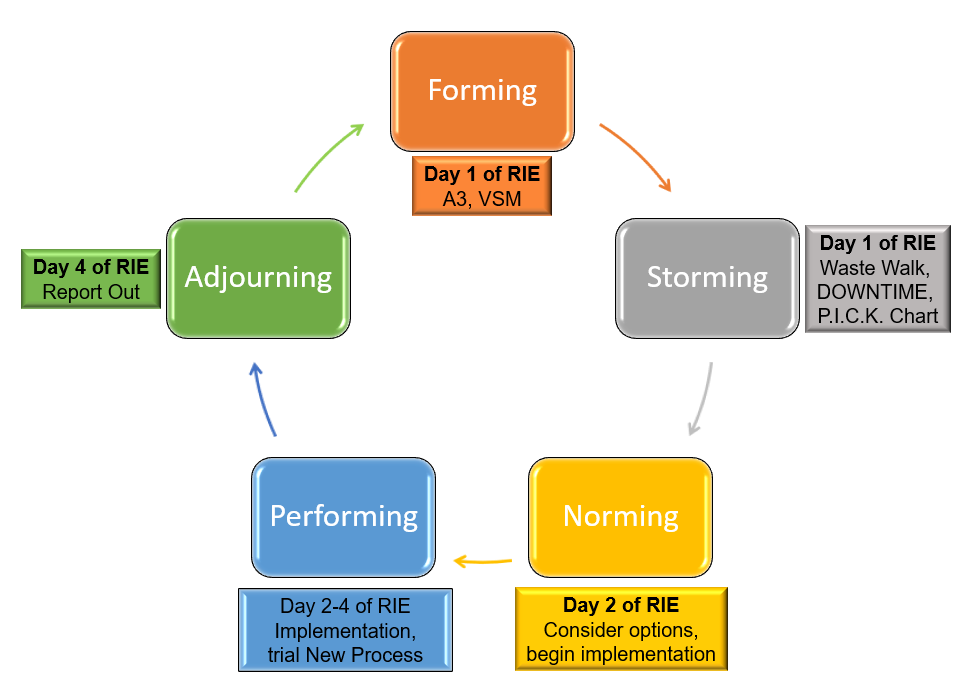I’m sure you have heard there are four stages of team development that each team goes through before they perform at a high level.
A Rapid Improvement Event (RIE) is a 3-5 day-long activity where you bring together team members from different areas to improve a process or department. Because of the short duration of the team, it’s important to move through the four stages of team development quickly.

Stage 1- Forming.
The team is brought together for the first time. Depending upon the team makeup and the size of your organization, some people may know each other and some might not. At this stage, team members are polite but often anxious.
Stage 2- Storming.
At this stage, team members jockey for informal leadership. Often there is angst because people have different working styles and they are now being asked to use a common style.
You may see team members resist in taking on tasks for the RIE. Pay special attention for this happening. It’s important to engage everyone and assure them their ideas are needed for success.
Stage 3- Norming.
In an RIE you have to get to this stage quickly. This is where team members become comfortable with each other and perform as a coherent unit. At this stage, employees will ask for constructive feedback on the ideas they bring to the table.
Stage 4- Performing.
This is where the team takes on the hard work of improving the defined area they are working on. There is little friction between team members and everyone pitches in to meet the stated goal.
Adjourning
The group returns to their normal work duties. They may have to re-convene briefly to continue to work on any open items, but the improvement activity that brought them together is complete.
Because an RIE has a defined beginning and end, you need to move through these four steps quickly. Here are three tips that will help you successfully move the team through the four stages of team development.
Tip 1- Have a defined project charter or A3.
Ensure there is a project sponsor, a team leader, and that the desired outcomes are established. Capture before and after metrics to measure improvement. Take before and after pictures of the area. Agree on how decisions will be made for the group. Voting, consensus, or some other manner.
Tip 2- Follow a defined RIE process.
I like to refer to Value Stream Maps that have been developed before the event. On day one of the RIE, go to the area and make sure everyone understands the goals to be met. Conduct brainstorming using the eight wastes and a PICK chart to narrow your solution options.
During day two, the team might develop new layout options. Look for ways to improve flow, eliminate inventory, and WIP. Try to balance operations with your new design.
Days three and four consist of trying the new options to see if you get what you expect. If you re-arrange the area, build a product down the line and learn. See where problems occur and work to eliminate them.
Tip 3- Have a formal report out at the end.
This is a way for the team to present their accomplishments and celebrate their success. It also acts as a formal adjourning of the group.
Make sure leadership team members are present in the report-out to show their support. If key members are missing, video the report out so they can watch it while they are traveling and thank participants upon their return.
There may be additional open items to be closed over time, but the main activity and purpose for the team are complete. Everyone is celebrated and the team can build upon the success of the event.
Make sure to thank the team for their hard work!
Following these three tips help you successfully move the team through the four stages of team development!
As always, it’s an honor to serve you and I hope this helps you and your organization get a little bit better today.
Listen to the episode here
Follow me on Twitter
Join me on LinkedIn
